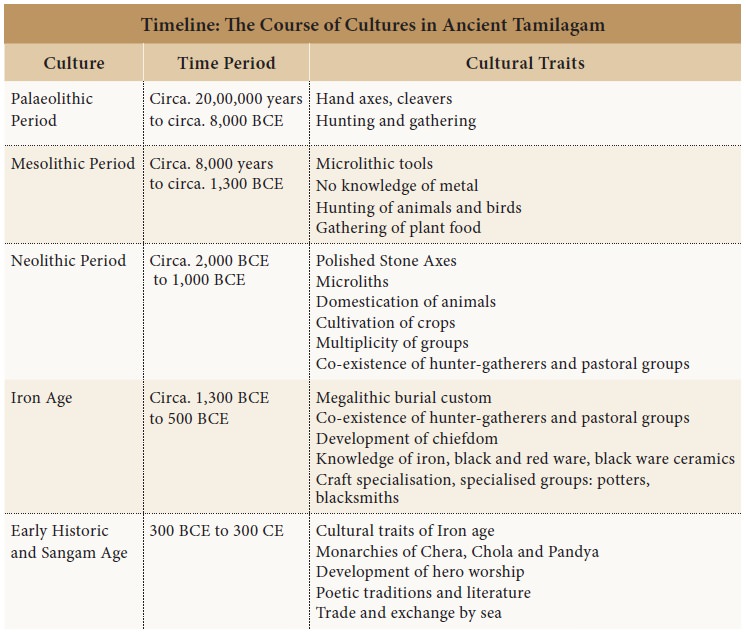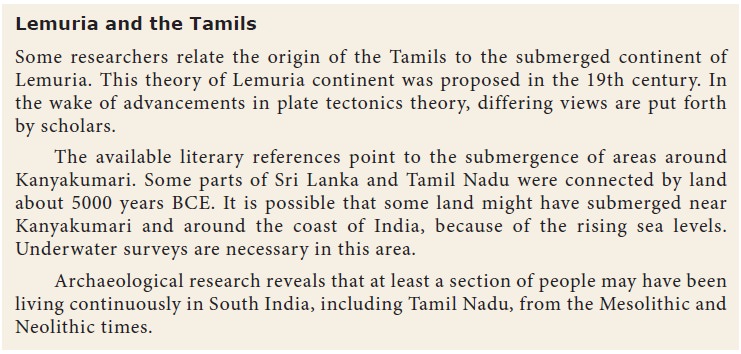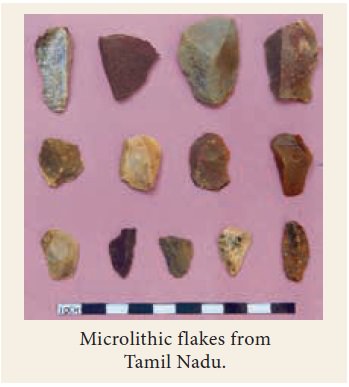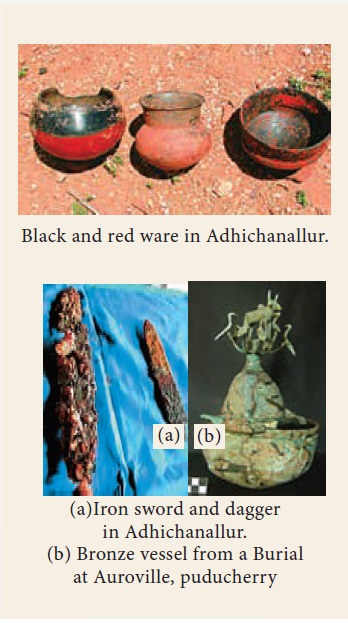History - Prehistoric Tamilagam | 9th Social Science : History : Evolution of Humans and Society - Prehistoric Period
Chapter: 9th Social Science : History : Evolution of Humans and Society - Prehistoric Period
Prehistoric Tamilagam
Prehistoric Tamilagam
Background to Prehistory
Have you ever thought about these questions?
·
The origin of the people in Tamil region.
·
How did cultures develop here?
We seek answer to these questions in this section.
In order to understand the cultural developments of
the Sangam Age (which we discuss in the third lesson), we need to know about
the prehistoric cultures of Tamil Nadu. Hence, let us see how and when humans
first emerged here, before knowing about the genesis of Tamil culture.

Lower Palaeolithic Culture in Tamil Nadu
One of the oldest Stone Age tools in the world made
by human ancestors, called hominins, had been
produced in Tamil Nadu. These stone
tools are found near the Chennai region at several sites, especially at
Athirampakkam. The archaeological excavations at this site and cosmic-ray exposure dating of the
artefacts suggest that people lived
here about 1.5 to 2 million years ago. The Kosasthalaiyar river is one of the
major cradles of human ancestors in the world. The people who lived here
belonged to the species of Homo erectus.
Archaeological excavation refers to digging undertaken
to recover archaeological evidence such as stone tools, pottery, animal bones
and pollens, in order to understand the past lifestyle of humans.
Cosmic-ray exposure dating – A method in which exposure to
cosmogenic rays is done for dating the samples.
In 1863, Sir Robert Bruce Foote, a geologist from
England, first discovered Palaeolithic tools at Pallavaram near Chennai. They
are the earliest finds of such tools in India. Hence, the hand axe assemblages
were considered the Madras Stone Tool Industry. The tools that he
discovered are now housed in the Chennai Museum.
The Palaeolithic people hunted wild animals and
gathered the naturally available fruits, roots, nuts and leaves. They did not
have knowledge of iron and pottery making, which developed much later in
history.
Hand axes and cleavers are the important tool types
of the Lower Palaeolithic period. These tools fitted with a wooden and bone
handle were used for cutting, piercing and digging. The people of this time
also used hammer stones and spheroids. The quartzite pebbles and cobbles were
chosen as raw materials. The tools are found in the soil deposits and also in
the exposed river side. They occur at Pallavaram, Gudiyam cave, Athirampakkam,
Vadamadurai, Erumaivettipalayam and Parikulam.


The Lower Palaeolithic tools are also found in the
North Arcot ![]() and Dharmapuri districts. The
people belonging to this period used basalt
rocks for manufacturing artefacts. However, the southern part of Tamil Nadu
and Sri Lanka do not have evidence of Lower Palaeolithic Culture.
and Dharmapuri districts. The
people belonging to this period used basalt
rocks for manufacturing artefacts. However, the southern part of Tamil Nadu
and Sri Lanka do not have evidence of Lower Palaeolithic Culture.
Basalt rocks are igneous rocks: Igneous rocks are those
formed from the molten lava from the earth.
The Lower Palaeolithic Culture is datable to about
2 - 1.5 million years at Athirampakkam. This cultural phase continued in other
parts of India up to 300,000 years ago.
Middle Palaeolithic Culture in Tamil Nadu
In the course of time, the Middle Palaeolithic Culture emerged
during 3,85,000 - 1,72,000 years
ago. The tool types of this period underwent a change and smaller artefacts
were used. Cores, flakes, scrapers, knives, borers, Levalloisian flakes, hand
axes and cleavers are the artefact types of this period. Compared to the
previous phase, these tool types became smaller in size.
Evidence for the Middle Palaeolithic Culture can be
observed in some parts of Tamil Nadu. In the southern part of Tamil Nadu, at T.
Pudupatti and Sivarakkottai, artefacts of the Middle Palaeolithic tools have
been collected. Also near Thanjavur and Ariyalur, similar artefacts have been
found.
Mesolithic Culture in Tamil Nadu
In many parts of the world, and in some parts of
India, the Upper Palaeolithic Culture succeeded the Middle Palaeolithic
Culture. There is no evidence for the Upper Palaeolithic Culture in Tamil Nadu.
But the people who used microliths
or small-stone artefacts lived in many parts of Tamil Nadu. Since this cultural
period

occurs between Palaeolithic and Neolithic Culture,
it is known as Mesolithic Culture or Middle Stone Age.
Evidence for the existence of Mesolithic
hunter-gatherers is found at Chennai,NorthArcot,Dharmapuri,Salem, Coimbatore,
Ariyalur, Tiruchirappalli, Pudukkottai, Madurai, Sivagangai, Tirunelveli and
Kanyakumari. The teri sites near Thoothukudi have evidence of microlithic
artefacts. These sites have red sand dunes called teris.
Mesolithic people might have engaged in fishing
activities. The microlithic artefacts of southern Tamil Nadu are also found in
the coastal regions of Sri Lanka. Geologists argue that the Tamil Nadu region
and Sri Lanka remained connected before 5000 BCE when the sea level was low.
The people of this period used small artefacts made
of chert and quartz. The tool types are scrapers,
lunates and triangles. These people hunted wild animals and gathered fruits, nuts and roots for their subsistence.
Scrapers are tools used for scraping the surfaces. Scrapers
are similar to the tools used in the kitchen for removing skin of
vegetables.
Triangles are tools in the shape of triangles.
Lunates are tools in the shape of a crescent.
Neolithic Culture in Tamil Nadu
The culture that domesticated animals and
cultivated crops is called Neolithic. It is known as the New Stone Age. The
Neolithic people used polished stone axes called celts. Cattle rearing was
their main occupation. They lived in small villages with houses made of
thatched roof and walls plastered with clay. Evidence of Neolithic village is found
at Payyampalli in Vellore district and a few sites in the Dharmapuri region.
Payyampalli is a village in Vellore district of
Tamil Nadu. The earliest evidence for the domestication of animals and
cultivation of plants is found at this site, which was excavated by the
Archaeological Survey of India. Evidence for pottery making and cultivation of
horse gram and green gram has been found in this village.
These Neolithic sites were part of the Southern Neolithic Culture of India. They are mainly concentrated in the Andhra Pradesh and Karnataka regions. The Neolithic people used stone axes fitted on a wooden handle.These polished stone axes are worshipped in many village temples of Tamil Nadu even today.
Iron Age/Megalithic period
The cultural
period that succeeded the Neolithic is called the Iron Age. As the name
suggests, people used iron technology. It preceded the Sangam Age. The Iron Age
was a formative period and the foundation for the Sangam Age was laid in this
time. During the Iron Age, many parts of Tamil Nadu were occupied by people. An
exchange relationship developed among the people.
The people of this age had knowledge of metallurgy
and pottery making. They used iron and bronze objects and gold ornaments. They
used shell ornaments and beads made of carnelian and quartz. The evidence for
Iron Age is found at many sites including Adhichanallur in Tirunelveli
district, Sanur near Madhuranthakam and Sithannavasal near Pudukkottai.
Megalithic burial sites are found in the whole of Tamil Nadu.
Megalithic Burial Types
The Iron Age is also known as megalithic, since
people created burials with large stones for the dead people. Within these
burials, the skeletons or a few bones of the dead persons were placed along
with grave goods including iron objects, carnelian beads and bronze objects.
Some of the burials do not have human bones and they have only the grave goods.
They may be called memorial burials.
Grave goods are the objects placed in the burials along with
the physical remains (bones) of the dead. People may have believed that these
would be useful in the after-life. Egyptian pyramids also have similar
artefacts.

Similar burials were also built in the early
historic period or the Sangam Age. The Sangam literature mentions the various
burial practices of the people. The megalithic burials are classified as
dolmens, cists, menhirs, rock-cut caves, urn burials and sarcophagus. The
burial types of Kodakkal (umbrella stone), Toppikkal (hatstone) and Paththikal
(hoodstone) are found in Kerala. Dolmens, table-like stone structures, were
erected as funerary monuments. Cists are stone enclosures buried under the
earth. They were created by placing four stone slabs on the sides, one on top
of each other. The cists and dolmens have openings called portholes. Urns are
pottery jars and were used for burying the dead. Sarcophagi are burial
receptacles made of terracotta. They sometimes had multiple legs. Menhirs are
pillar-like stones erected as part of the burials or memorials.
Portholes are holes found in the cists and dolmens on one
side. They may have acted as the entrance to the burials. There is a view that
they were meant for the movement of the soul or spirit.
Why did they build using numerous burial types?
What is the basis of this variation? There could be several factors influencing
the megalithic burial types. For example, social status or the importance of
the individuals buried or simply the choice of the relatives of the dead could
have been the reasons. Raw material availability is another reason. In the
deltaic areas where stones are not available, people used the simple urns made
by potters using clay.
The menhirs may have been erected for the heroes in
the Iron Age. The tradition of hero stones might have begun in the Iron Age or
even before.
Agriculture and Pastoralism
The people in the Iron Age practiced agriculture,
domesticated cattle and sheep, and some of the groups were still hunting and
gathering. Millets and rice were cultivated. Irrigation management developed in
this period, since many of the megalithic sites are found nearby rivers and
tanks. In the deltaic regions, irrigation as a technology had developed.
Evidence of rice is seen in the megalithic sites like Adhichanallur in
Thoothukudi district and Porunthal near Palani.
Iron Age Society and Polity
The Iron Age society had farming communities,
pastoralists and hunter-gatherers. Craft specialists, potters and blacksmiths
were the professionals during this period. The society had several groups of
peoples (tribes). The size of the burials and the variations found in the
burial goods suggests the existence of numerous social groups and their diverse
practices. Some of them seem to have had organised chiefdoms. Cattle lifting
leading to wars and encroachment and expansion of territories had also started
taking place in this period.
Chiefdoms were stratified societies in which chiefs were
selected based on kinship relations.
The Ashokan inscriptions datable to third century
BCE refers to the Cheras, Cholas, Pandyas and Satyaputras outside his empire in
Tamilagam. If the Cheras, Cholas, Pandyas and Satyaputras had been powerful
political powers in the Mauryan period, they must have commenced their
political rule in the Iron Age.

Pottery
Pottery is an important evidence found in the
archaeological sites. The Iron Age and Sangam age people used the black and red
colours to make black ware and red ware pottery. Potteries were used for
cooking, storage and dining purposes. The black and red ware pottery has a
black inside and a red outside, with lustrous surfaces.
Iron Technology and Metal Tools
The megalithic burials have abundant iron objects
placed in the burials as grave goods. Weapons such as swords and daggers, axes,
chisels, lamps and tripod stands are also found. Some of these objects were
hafted to wooden or bone or horn handles and used. The iron tools were used for
agriculture, hunting, gathering and in battles. Bronze bowls, vessels with
stylish finials decorated with animals and birds, bronze mirrors and bells have
also been found.
Related Topics